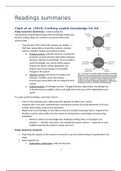Readings summaries
Clark et al. (2016) Crafting usable knowledge for SD
Things researchers should know: Understanding the
coproduction relationships through which knowledge making and
decision-making shape one another in social-environmental
systems (SES)
- Coproduction: SESs continually reshape one another -->
ICAP lens: seeing SESs as innovation systems, complex
systems, adaptive systems and political systems
o Complex system: collective behaviors results from
properties of parts and their interactions between
the parts and their surroundings. Thus to produce
useful knowledge, you cannot isolate aspects,
impacts are always context dependent and
impacts may involve abrupt or irreversible
changes to the system
o Adaptive systems: processes of variation and
selection novelties result from human-
environment interactions and are shaped by local
context
o Political systems: ‘knowledge is power’ struggle between stakeholders. Knowledge has
to be perceived as credible, salient, and legitimate in the eyes of the stakeholders to be
useful.
To create useful knowledge, researches need to
- Listen to the potential users, addressing their agendas to reflect users’ needs
- Integrate their work with complementary innovation processes involving adjustment to fit local
context, field testing, scale-up and retirement
- Realize that new knowledge is more likely to become useable knowledge when it shaped to the
fit within and thus draw utility from the system of existing ideas, technologies and governing
institutions
o Need for radical new knowledge that challenges existing ideas, technologies and
practices --> still find connections into existing innovation systems --> depends on actor
coalitions pushing the system to adopt and use it
Things researchers should do:
1. Improving the capacity of the research community to put its understanding of coproduction into
steps
2. Build capacities for
a. Stakeholder collaboration: wide and inclusive
1
, i. Researchers cannot craft useable knowledge on their own
ii. Moral and ethical dimensions of working with people whose lives are effected
by the decisions
iii. Boundary work: engagement at the interface among potential collaborators to
address practical, political and cultural mismatches
b. Social learning: learning that takes place beyond the level of the individual, continuous
and contextualized
i. Value learning over knowing
ii. Create safe spaces in research arenas reward error and failure
iii. Research design needs to facilitate individual capacities
iv. Critically examining scientific institutions that favor ivory tower knowledge
c. Knowledge governance: recognizing and reshaping the rules and norms governing the
relationships of coproduction
i. Knowledge production, sharing, access, and use
ii. Connecting knowledge across sites
iii. Scaling up research outcomes to larger programs or policies
iv. Providing broader structural issues
d. Researcher training: approaches that incorporate additional skills and perspective that
will help to produce academically rigorous, useable and practical knowledge
Kim (1995) Guidelines for drawing causal loop diagrams
Causal loop diagrams link together key variables and indicate the causal relationships between them.
- Arrow with a s: change in same direction
- Arrow with an o: causal change in opposite direction
- B: balancing loops goal-seeking, steady around a particular goal
- R: reinforcing loops rapid growth or collapse
Guideline
Selecting variable names 1. use nouns for variable names, actions are embedded in the arrows
2. use variables that represent quantities that can vary over time
3. choose positive sense of a variable name
Loop construction 4. think of possible unintended consequences and expected outcomes for
every course of action
5. make the goals of balancing loops clear
6. distinguish between perceived and actual states
7. if a variable has multiple consequences, lump them into one term while
completing the rest of the loop
8. draw larger loops as consequences progress from short- to long-term
General tips 9. if a link needs a lot of explanation, redefine the variables or insert an
intermediate term
10. shortcut for determining whether a loop is balancing or reinforcing,
count the o’s (even reinforcing, uneven balancing)
2
,Kim (1999) Introduction to systems thinking
Systems thinking is a way of seeing and talking about reality that helps to better understand and work
with systems to influence the quality of lives. A system is a group of interacting, interrelated or
interdependent parts that form a complex and unified whole that has a specific purpose. Characteristics
of systems:
- Systems have purpose
- All parts must be present for a system to carry out its purpose optimally
- The order in which the parts are arranged affects the performance
- Systems attempt to maintain stability through feedback feedbacks let the system know how
they are doing relative to its desired state
A key to understanding systems is knowing its purpose, either as a separate entity or in relation to a
larger system. The purpose of natural systems are harder to find and because of this, we tend to take
actions in these systems without really understanding he impact of our actions, risking the breakdown of
a system.
We can view reality from the multiple levels of perspective:
- Events: occurrences we encounter on day-to-day basis
- Patterns: accumulated memories of event
- Systemic structures. : the ways in which the parts of a system are organized,
generating the patterns and evens we observe
To know what systems do, we have to deepen our understanding of how it behaves
and gain familiarity with some terms and tools of systems thinking in order to communicate our
understanding.
Feedback loop perspective: the world as interconnected set
of circular relationships, where something affects something
else and is in turn affects by it
Reinforcing processes: engines of growth and collapse
Balancing processes: the great stabilizers
- The state as it is
- The desires state
- Our perception of the state
Gaps
Delays in systems
- Physical: amount of time needed for stuff to move
or change
- Transactional: all transactions take time
3
, - Informational: associated with communicating
information about physical changes
- Perceptual: beliefs and assumptions are deep and
thus slow to change
Stock and flow diagrams are another way to illustrate
systems
- Stocks/accumulators: anything that can accumulate
and be measured
- Flows/rates: things that change over time
- Provides information on rate of change
- Used to build computer simulation models
De Vries (2013) Chapter 2 Systems Dynamics Perspective
A system is an interconnected set of elements that is coherently organized around some purpose
Key attributes:
o Elements
Easy to observe
Element identification depends on scale, resolution and objective of analysis
o (inter)connections
Represent physical, monetary and informational flows and the laws and rules
that govern these flows
o Purpose
Only makes sense in a holistic, phenomenological perspective
Goal is generally to survive, sustain and evolve
Only possible to look at purpose through a cognitive understanding --> makes
purpose contextual and anthropocentric
System integrity or wholeness --> more than a sum of its parts
Systems dynamics practices an open enquiry into the object system, starting with a conceptual model
and a focus on qualitative relationships, the resulting schemes are called causal loop diagrams. The next
step is to formalize the conceptual model into equations and search for solutions. Systems have
nonlinearities, delays and feedbacks and the use of mathematical techniques often lead to extreme
simplifications and simulation is used to analyze otherwise intractable systems.
Stocks: content of reservoirs --> accumulated stuff within a given system boundary
o Integrals
4






